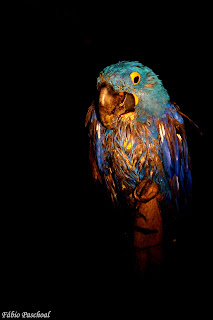Nome: Tamanduá Bandeira
English name: Giant Anteater
Family: MYRMECOPHAGIDAE
Species: Myrmecophaga tridactyla
IUCN Status: Vulnerable
Pictures taken at: Pantanal
Natural History: The Giant Anteater has a name that might fool. Of course it eats ants, but termites are also part of the menu. With its sticky saliva and its 30 cm tongue it catches 30 thousand of those insects a day. It is a unique animal that is found only in Central and South America.
It walks on the
knuckles so its claws never touch the ground and stay sharped all the time and it can dig for termites and ants. When threatened it stands on its hind legs and open the arms showing the huge claws. If the threat approaches it gives a hug that is capable of killing a Jaguar. For that reason, here in Brazil, if someone that doesn't likes you gives you a hug, we say that this person is giving you a Giant Anteater's hug.
When it is time to sleep, the Giant Anteater cover itself with the tail, using it as a blanket, in that way he is protected against the cold and remain camouflaged, looking just like a bush.
Filhote de Tamanduá Bandeira/ Baby Giant Anteater
|
It has a black band on both sides of its body that has a very interesting purpose: The giant anteater carries the baby on its back, as the baby has the same black band on the sides, when the little one is comfortably riding the black bands mach, so its very difficult to see the baby from the distance and it stays protected against predators.
Threats: They are losing their habit specially for soy plantation and are killed on the roads. As it has very poor eyesight and hearing they are hit by car and trucks when trying to cross.
História Natural: O Tamanduá Bandeira se alimenta de formigas e cupins, com sua lingua pegajosa com mais de 30 cm pega 30 mil desses insetos por dia. É um animal único encontrado somente nas Américas Central e do Sul. Anda em cima dos nódulos dos dedos para manter suas garras afiadas podendo procurar por alimento e se defender.
Possui uma articulação na coluna que o permite ficar apoiado somente nas patas traseiras, quando desfere o famoso abraço do Tamanduá. Com esse abraço o Tamanduá Bandeira pode matar até uma Onça. Quando vai dormir utiliza seu rabo como um cobertor, coloca-o sobre o corpo para se proteger do frio e acaba ficando camuflado como um arbusto.
Tem uma banda preta e triangular nas laterais do corpo muito interessante: O Tamanduá Bandeira carrega o filhote nas costas, como o filhote também possui a banda preta e triangular nas laterais, as bandas se sobrepõe. Com isso fica quase impossível de dizer que há um filhote nas costas da mãe evitando que predadores venham comer o pequenino tamanduá bandeira.
Ameaças: Estão perdendo o habitat, especialmente para plantações de soje. Outra ameaça são as estradas, como o tamanduá tem visão e audição muito pobres, não percebem que um carro ou caminhão está chegando e acabam sendo atropelados.
Ameaças: Estão perdendo o habitat, especialmente para plantações de soje. Outra ameaça são as estradas, como o tamanduá tem visão e audição muito pobres, não percebem que um carro ou caminhão está chegando e acabam sendo atropelados.




















